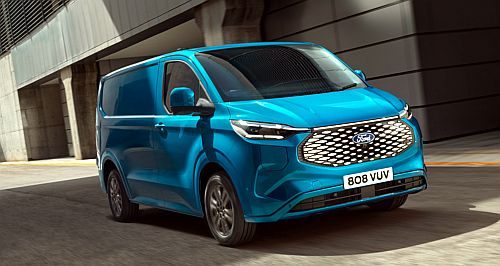Tradie friendly Ford E-Transit Custom?
BY TONY O'KANE | 4th Jun 2024

BY THE end of this year Ford Australia will have a second all-electric commercial van in its showroom in the E-Transit Custom, which takes the second-generation Transit Custom’s all-new platform, deletes the diesel and transplants a 64kWh battery and a rear-mounted electric motor underneath.
Apart from the expected benefits of all-electric propulsion – refinement, environmental friendliness and low running costs, Ford is quietly confident that it may provide an advantage in total cost of operation (TCO) too.
Speaking with GoAuto at the E-Transit Custom’s global media launch in Germany, Ford Australia general manager of fleet Christine Wagner said that the battery-electric (BEV) van held one critical advantage over its combustion-engined siblings – maintenance.
While costings for the maintenance schedule are still being finalised (as is the E-Transit Custom’s Australian pricing), the all-electric van will run to a 24-month, unlimited-kilometre servicing interval – double what Ford stipulates for the new diesel Transit Custom.
A diesel Custom has 12-month/30,000km intervals with costs capped at $499 for the first four services, then $580 for each service beyond that.
That works out at $3156 for the first six years of operation for the diesel Transit Custom, so if the E-Transit Custom can significantly undershoot that number, it represents one more benefit for operators who’ll already enjoy lower per-kilometre running costs if they are able to charge on cheap energy.
“If you look at the use case, over time in a much more pragmatic sense, the fact that you don't have to service the vehicle anywhere near as much, the fact that the number of moving parts are significantly less, your uptime is going to be significantly improved,” Ms Wagner said.
“The TCO equation for the Transit Custom versus the E-Transit Custom runs much closer than in some other segments, like heavy-duty trucks.
“I think what we're finding (regarding TCO) is that you're not upside-down, you're probably more line-ball, generally speaking,” Ms Wagner continued.
“But I think we don't really have a good handle on that information as yet, because we really don't understand where the residual value is going to go.”
Nor does anyone outside of Ford know the E-Transit Custom’s retail price, which is the other unknown variable that will have a big say on its TCO.
The company says it’s still finalising the price of its electric midsize van range, which will launch in the final quarter of 2024 in long-wheelbase form with a standard roof or high roof, with a 64kWh lithium-ion NMC battery and a 160kW/415Nm single motor driving the rear wheels.
Lower (100kW) and higher (210kW) power outputs exist for the European market, but Ford Australia is sticking with the mid-strength 160kW powertrain for now.
Its single-charge range of 308km (WLTP) may be an automatic deal-breaker for some users, but a 124kW DC fast-charging capability that may take it from 15-80 percent in 41 minutes for operators that get caught short when away from home or the depot.
Where will it sit?
The diesel Transit Custom range which has already started arriving in Australia tops out at $62,990 (before on-road costs) for the Sport Double Cab variant, so it is unlikely that the E-Transit Custom will lob below that number (especially as its prime rival, the LDV eDeliver 7 LWB retails for $65,253 + ORC).
Meanwhile, a recent price cut has seen Ford’s first BEV van, the larger E-Transit, fall a whopping $15,000 to $89,990 + ORC, effectively setting a ceiling for the smaller E-Transit Custom. Expect it to arrive somewhere north of $70K, at a minimum.
Resale or residual values will not be known until after the E-Custom enters the market and it is residuals that usually provide the biggest sting when calculating TCO – which subtracts resale, operational, registration, insurance and maintenance costs from the vehicle’s price of acquisition.
For business operators, especially larger fleets, is often a deal-making or deal-breaking number.
In the passenger vehicle space, a pattern of poor residuals for battery-electric models is emerging.
Some of it has been skewed by recent and significant price cuts of new models by Tesla, which dominates the Australian battery electric vehicle market, but question marks over battery longevity and charger network reliability have seen some motorists questioning the wisdom of paying high prices for a used BEV.
So much so, that Hyundai Australia has established its own captive finance company to offer a guaranteed future value for the cars it sells especially its BEVs.
In the commercial space, there is certainly scepticism at the larger end of the size spectrum.
“For TCO… you will not get (it)”, said Manfred Streit, managing director of Scania Australia, earlier this year when asked by GoAuto about whether battery-electric trucks were TCO-competitive with their diesel-powered equivalents.
“Just the price of the product, and the battery … the front price is so high, and the energy and the electricity is not so cheap unless you produce it yourself,” Mr Streit continued.
Scania already has a robust electrification roadmap that not only includes municipal BEV buses which are already in service in Australia but also heavy duty trucks, however Mr Streit says that examining large commercial electric vehicles from a TCO point of view does not make sense – yet.
But if Ford’s crystal ball proves accurate it appears that outlook may not necessarily apply at the smaller end of the commercial vehicle market and for the thousands of small businesses and sole traders who are wondering when might be the right time to go all-electric, that time might be approaching. If the numbers make sense.